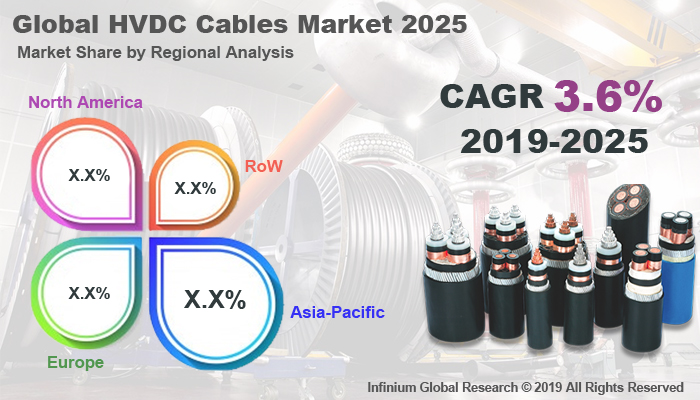HVDC Cables Market (Type - Mass Impregnated Cables, Extruded Cables, and Other Types; Applications - Overhead Line, Submarine, and Underground): Global Industry Analysis, Trends, Size, Share and Forecasts to 2025
A recent report
published by Infinium Global Research on HVDC cables market provides in-depth
analysis of segments and sub-segments in the global as well as regional HVDC
cables market. The study also highlights the impact of drivers, restraints, and
macro indicators on the global and regional HVDC cables market over the short
term as well as long term. The report is a comprehensive presentation of
trends, forecast and dollar values of the global HVDC cables market. According to
the report, the global HVDC cables market is projected to grow at a CAGR of
3.6% over the forecast period of 2019-2025.
Market Insight
High Voltage
Direct Current (HVDC) has become the leading technology for long-distance
transmission of bulk power in recent years. The rapid development and the
increased assurance in the HVDC technology have caused the transition from ac
to dc. The demands for huge renewable energy integration, passive network power
supply, and global energy interconnection have all steadily increased new
challenges for high voltage direct current (HVDC) power transmission systems.
Additionally, global energy interconnection has become gradually popular. High
voltage direct current (HVDC) transmission systems provide favorable access to
circulated renewable energy and passive networks. Transmitting energy from
renewable sources would require high voltage lines. HVDC is more suitable as
compared to HVAC for this purpose.
The factors
such as an expansion of industries, urbanization, need for electricity, and
long-distance transmission network is major driving factors of the HVDC cables
market. HVDC enables protected and steady interconnection of power networks
that operate on different frequencies and provides instant and precise control
of the power flow. Furthermore, the increasing demand for outsourced service
providers, growing focus on renewable energy assets with an objective to
achieve energy efficiency will further complement the business outlook are also
driving the growth of the market. However, the required high cost of converting
and inverting equipment’s for HVDC transmission and problems related to the
acquisition of land restrains the market growth. Moreover, increasing focus on
renewable energy assets to achieve energy efficiency is anticipated to provide
wide opportunities in the future.
Geographically,
Asia-Pacific dominates the global HVDC cables market.
The factors such as technological advances as ultrahigh-voltage direct current
(UHVDC) technology and voltage source converter (VSC) based technology for
power transmission is driving the growth of the market in this region.
Further, the development of power infrastructure and government initiatives and
investments in renewable energy sources and application of smart grid
technology is expected to boost the market growth in countries such as China,
India, and Japan in the future.

Segment Covered
The report on
global HVDC cables market covers segments such as type and applications. On
the basis of type, the sub-markets include mass impregnated cables, extruded
cables, and other types. On the basis of applications, the sub-markets include
overhead line, submarine, and underground.
Companies Profiled:
The report
provides profiles of the companies in the market such as NKT A/S, LS Cable
& System Ltd., ABB, Siemens, Nexans Group, General Electric, Hitachi,
Mitsubishi Electric, NR Electric, C-Epri Electric Power Engineering, and other
companies.
Report Highlights:
The report
provides deep insights into the demand forecasts, market trends, and micro and
macro indicators. In addition, this report provides insights into the factors
that are driving and restraining the growth in this market. Moreover, The IGR-Growth
Matrix analysis given in the report brings an insight into the investment areas
that existing or new market players can consider. The report provides insights
into the market using analytical tools such as Porter's five forces analysis
and DRO analysis of HVDC cables market. Moreover, the study highlights current
market trends and provides forecast from 2019-2025. We also have highlighted
future trends in the market that will affect the demand during the forecast
period. Moreover, the competitive analysis given in each regional market brings
an insight into the market share of the leading players.
